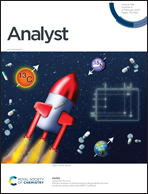SERS-based error calibration of a TMB–H2O2 colorimetric system
Abstract
3,3′,5,5′-tetramethylbenzidine (TMB)–H2O2 is widely used as an effective colorimetric system, in which the color reaction is implemented with peroxidase-catalyzed TMB oxidation by H2O2 that usually measured UV-vis absorption spectra or Raman spectra. However, its low accuracy significantly limits its application. Blue charge transfer complex (CTC), which is the product of TMB and H2O2 reaction and is used as the basis for partial colorimetric methods, usually causes colorimetric error owing to changes in the UV-vis absorption and Raman spectra during TMB oxidation under various environmental conditions (catalyst type, temperature, H2O2 concentration). Herein, we propose a surface-enhanced Raman spectrum (SERS)-based error calibration method to improve the accuracy of the TMB–H2O2 colorimetric system. It is found that under 633 nm laser excitation, TMB has three Raman peaks at 1189, 1335 and 1609 cm−1 in the single-electron oxidation phase, and these peaks disappear completely in the two-electron oxidation phase. By comparing these Raman peaks, we can conveniently obtain the actual process information during TMB oxidation. Using the proposed method, the accuracy of the TMB–H2O2 colorimetric system improved by more than 15%. Importantly, this SERS-based TMB–H2O2 error calibration method will open a new horizon for enzyme-linked immunosorbent assay (ELISA) and other biomedical applications.



 Please wait while we load your content...
Please wait while we load your content...